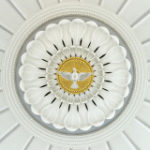Our celebration of the Eucharist on this Mother’s Day in the Mother Church of the United States takes on its full meaning from the readings of the word of God just now proclaimed. We pray for and we give thanks to God for our mothers in the context woven by that powerful word.
As we remember with gratitude our own mothers, we give thanks to God for what happened in this Mother Church, where over time the family of faith has been assembled and nourished through the breaking of the bread of life.
In the second chapter of the Acts of the Apostles, St. Luke describes the life of the early church as dependent on the teaching of the apostles and “the breaking of the bread and the prayers.” We know that the term “the breaking of the bread” referred to what we are about this morning, namely, the celebration of the Eucharist.
Today we hear a reading from the Fourth Chapter of Acts, as the Apostle Peter addresses the “leaders of the people and elders.” Peter speaks to them of the good deed, the healing accomplished by the power of Jesus in the healing of a cripple. He emphasizes that in no name other than that of Jesus can our human family be saved. At the same time, as we reflect on the death of Jesus, we are taught by the Council of Trent that he died because of the sins of all of us, that this Eucharist is another moment in which his saving, loving power comes to touch and heal us spiritually, and it is a healing and a help for which our spirits hunger.
Bishop John Carroll, born of a Maryland mother and father, chose to be ordained a bishop on a feast of our heavenly mother, the Feast of the Assumption of the Blessed Virgin Mary, 1790, at St. Mary’s Chapel, Lulworth Castle, England. Because of the anti-Catholic penal laws, the ceremony was a private one, not advertised ahead of time.
When Pope Pius VI named Father John Carroll the first Catholic bishop in the infant United States of America, he charged him to see to the construction of a cathedral in which “the breaking of the bread” would be the central, indeed, the crowning liturgical event. Bishop John Carroll went about the task carefully, deliberately. A board of trustees was formed in 1795. A few years later, architect Benjamin Henry Latrobe, the only master architect in the infant country, heard of the project and volunteered his services pro bono. At the time he was working for President Thomas Jefferson in designing the first U.S. Capitol.
Begun in 1806, this cathedral was intended to serve as a seat of a bishop responsible for the preaching of the gospel and giving direction to the life of Catholics in what today are more than 35 states of the present United States. The Diocese of Baltimore, in 1806, comprised, besides the 13 original states, also the Northwest Territory, the Middle West as we know it today. When the Louisiana Purchase was concluded in 1804, the territory for 15 future states was acquired by the United States. Pope Pius VII named Bishop Carroll Apostolic Administrator of the Diocese of New Orleans, embracing the Louisiana Purchase Territory. A responsibility he retained until 1815. He became Archbishop Carroll and saw the diocese divided in 1810, with the first bishops of Philadelphia, Boston and Bardstown, Kentucky, ordained in Baltimore in 1810. The first bishop of New York, an Irish Dominican, was ordained in Rome, but died in Naples.
At first Latrobe wanted to build a Gothic church, but Bishop Carroll pressed for a Neo-Classical design. He wanted to see the Lulworth Chapel, where he became a bishop, on a larger scale. At the same time he looked for a church to link this country’s first cathedral with the architectural style of the newly emerging federal buildings in the District of Columbia.
Built high on a hill, the Cathedral of Baltimore, now the Basilica, became a symbol of the city. In its original design, the interior was bathed with natural light from windows in the dome, and the c

